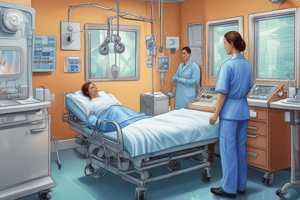Podcast
Questions and Answers
Which of the following is NOT a focus of the content mentioned?
Which of the following is NOT a focus of the content mentioned?
What is the relationship between the 'Lippincott CoursePoint Enhanced' and the 'Brunner & Suddarth's Textbook of Medical-Surgical Nursing'?
What is the relationship between the 'Lippincott CoursePoint Enhanced' and the 'Brunner & Suddarth's Textbook of Medical-Surgical Nursing'?
Who are the primary authors of the textbook?
Who are the primary authors of the textbook?
What does the term 'Enhanced' refer to in 'Lippincott CoursePoint Enhanced'?
What does the term 'Enhanced' refer to in 'Lippincott CoursePoint Enhanced'?
Signup and view all the answers
Which of these would LEAST likely be included in the materials from 'Lippincott CoursePoint Enhanced'?
Which of these would LEAST likely be included in the materials from 'Lippincott CoursePoint Enhanced'?
Signup and view all the answers
Study Notes
Introduction to Medical-Surgical Nursing
- Brunner & Suddarth's Textbook of Medical-Surgical Nursing is a comprehensive resource for medical-surgical nursing practice.
- The Lippincott CoursePoint Enhanced version offers interactive features and resources for learning.
- The text is known for its practical approach, emphasizing patient care and clinical reasoning.
- It covers a wide range of medical-surgical conditions and procedures.
Key Concepts in Medical-Surgical Nursing
- Patient-Centered Care: Prioritizes the patient's preferences, values, and needs throughout the care process.
- Evidence-Based Practice: Emphasizes using research-supported strategies and interventions to improve outcomes.
- Critical Thinking: Involves analyzing patient data and making sound judgments about appropriate care plans.
- Communication: Effective communication is crucial for providing quality patient care. Nurses need to communicate clearly with patients, families, and other healthcare professionals.
- Collaboration: Working effectively with other healthcare professionals, such as physicians, pharmacists, and social workers, is essential.
- Safety: Ensuring a safe environment for patients, while following all established safety protocols.
- Professionalism: Maintaining ethical conduct, maintaining confidentiality, and adhering to legal obligations.
- Health Promotion: Empowering patients and families to proactively engage in maintaining their health.
- Cultural Competence: Understanding and respecting diverse cultural backgrounds and practices.
Key Content Areas in the Textbook
- Assessment: Includes methods for gathering subjective and objective patient data, including physical assessment techniques.
- Diagnosis: Explores various nursing diagnoses and how nurses formulate these diagnoses.
- Planning: Outlines comprehensive care plans based on prioritized patient needs.
- Implementation: Focuses on safe and effective nursing interventions, procedures, and treatments.
- Evaluation: Evaluates the effectiveness of nursing strategies and adjusts care plans as needed.
Common Medical-Surgical Conditions Covered
- Cardiovascular Disorders: Includes heart failure, coronary artery disease, hypertension, and various arrhythmias.
- Respiratory Disorders: Features respiratory infections, asthma, chronic obstructive pulmonary disease (COPD), and pneumonia.
- Gastrointestinal Disorders: Details conditions like gastroesophageal reflux disease (GERD), peptic ulcer disease, and inflammatory bowel disease (IBD).
- Endocrine Disorders: Covers diabetes mellitus, thyroid disorders, and adrenal insufficiency.
- Neurological Disorders: Includes stroke, seizures, multiple sclerosis, and spinal cord injuries.
- Genitourinary Disorders: Explores kidney disease, urinary tract infections, and sexual health issues.
- Hematologic Disorders: Features anemia, leukemia, and various blood clotting disorders.
- Oncology: Covers cancer diagnosis, treatment, and management.
- Trauma and Critical Care: Includes emergency medical care, trauma management, and intensive care.
Additional Features of the Text and Enhanced CoursePoint
- Interactive Activities: Online interactive exercises and simulations.
- Case Studies: Real-life scenarios to apply knowledge in clinical settings.
- Patient Education Resources: Materials and tools for helping patients understand and manage their conditions.
- Videos and Animations: Detailed visuals to clarify complex medical concepts.
- Study Tools and Resources: Includes chapter summaries, flashcards, and practice quizzes.
- Clinical Decision Support Systems (CDSS): Resources and tools to aid in the decision-making process.
Overall Study Approach
- Understand the core concepts in medical-surgical nursing.
- Actively engage with the interactive features of the Lippincott CoursePoint.
- Thoroughly review the presented medical-surgical conditions, and learn the applicable nursing care.
- Focus on developing critical thinking skills through case studies and simulations.
- Practice using evidence-based strategies in clinical settings.
- Continuously update knowledge based on current research and medical advancements.
Studying That Suits You
Use AI to generate personalized quizzes and flashcards to suit your learning preferences.
Description
Explore key concepts in Medical-Surgical Nursing including patient-centered care, evidence-based practice, critical thinking, and effective communication. This quiz will test your understanding of the essential principles outlined in Brunner & Suddarth's Textbook. Enhance your nursing practice through engaging and interactive learning.




